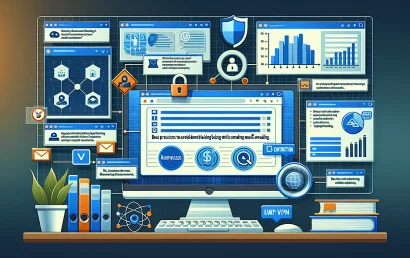How to Properly Warm Up a Domain Before Sending Emails?

When it comes to email marketing, one of the most crucial steps is ensuring that your domain is properly warmed up before launching any campaigns. This process, often referred to as «domain warming,» is essential for maintaining a good sender reputation and improving deliverability rates. If you skip this step, your emails may end up in the spam folder, or worse, your domain could be blacklisted.
So, how do you effectively warm up your domain? In this article, we will explore the best practices and strategies for gradually increasing your email sending volume while establishing trust with Internet Service Providers (ISPs). By following these guidelines, you can maximize the chances of your emails reaching their intended recipients and achieving your marketing goals.
Understanding the Importance of Domain Warming
Before diving into the specifics of how to warm up your domain, it's essential to understand why this process is necessary. When you send emails from a new domain or an inactive one, ISPs are cautious. They monitor the behavior of the sender to determine if the emails are legitimate or spam. A sudden surge in email volume can raise red flags and negatively impact your sender reputation.
The Risks of Not Warming Up Your Domain
Failing to warm up your domain can lead to several issues:
Increased Bounce Rates: If your emails are flagged as spam, you may experience high bounce rates, which can harm your domain's reputation.
Poor Deliverability: Without proper warming, your emails may not reach inboxes, resulting in wasted time and resources.
Blacklisting: In extreme cases, your domain could be blacklisted, making it nearly impossible to reach your audience.
Steps to Warm Up Your Domain
Now that we understand the importance of domain warming, let's explore the steps you should take to ensure a successful process.
Start Slow and Gradually Increase Volume
Begin by sending a small number of emails each day. This could be as few as 10 to 20 emails initially. As your domain gains credibility, you can gradually increase the volume. A common approach is to double your sending volume every few days, but always monitor the response and adjust as necessary.
Engage with Your Audience
During the warming process, focus on sending emails to engaged recipients. This means targeting users who are likely to open, read, and interact with your emails. High engagement rates signal to ISPs that your emails are wanted and trustworthy.
Monitor Your Metrics
Keep a close eye on key performance indicators (KPIs) such as open rates, click-through rates, and bounce rates. These metrics will help you assess the effectiveness of your warming strategy and make necessary adjustments.
By following these steps, you can effectively warm up your domain and set the stage for successful email marketing campaigns.
Main advantages and disadvantages
Advantages of Warming Up Your Domain
Warming up your domain offers several significant benefits that can enhance your email marketing efforts:
- Improved Deliverability: A well-warmed domain is more likely to have emails delivered to the inbox rather than the spam folder, increasing the chances of your message being seen.
- Better Sender Reputation: Gradually building your sending volume helps establish a positive sender reputation with ISPs, which is crucial for long-term success in email marketing.
- Higher Engagement Rates: By focusing on sending to engaged recipients during the warming process, you can foster better relationships with your audience, leading to higher open and click-through rates.
- Reduced Risk of Blacklisting: A gradual increase in email volume minimizes the risk of being flagged as a spam sender, protecting your domain from potential blacklisting.
Disadvantages of Warming Up Your Domain
While warming up your domain is essential, there are some drawbacks to consider:
- Time-Consuming: The warming process can take several weeks, delaying the launch of larger email campaigns and potentially hindering marketing efforts.
- Requires Consistent Monitoring: To successfully warm up your domain, you need to actively monitor metrics and adjust your strategy, which can be resource-intensive.
- Initial Low Engagement: Early in the warming process, you may experience lower engagement rates as you are still building your sender reputation and audience trust.
- Potential for Mistakes: If not done correctly, domain warming can backfire, leading to increased bounce rates and damage to your sender reputation.
Thematic table
| Step | Description | Best Practices | Tools/Resources |
|---|---|---|---|
| Start with a Low Volume | Begin by sending a small number of emails daily to establish a baseline. | Send 10-20 emails per day at first. Gradually increase the volume. | Email marketing platforms (e.g., Mailchimp, Sendinblue) |
| Gradually Increase Volume | Double your sending volume every few days as your domain gains credibility. | Monitor engagement and adjust the increase pace based on performance. | Analytics tools (e.g., Google Analytics, email platform analytics) |
| Target Engaged Recipients | Focus on sending emails to users who are likely to open and interact with them. | Segment your audience based on previous interactions and engagement. | CRM tools (e.g., HubSpot, Salesforce) |
| Monitor Key Metrics | Keep track of open rates, click-through rates, and bounce rates to assess performance. | Set benchmarks for acceptable performance and adjust strategy accordingly. | Email marketing analytics dashboards |
| Maintain Consistency | Send emails consistently to build trust with ISPs and your audience. | Aim for a regular sending schedule (e.g., weekly or bi-weekly). | Email scheduling tools (e.g., Buffer, Hootsuite) |
| Engage with Feedback | Encourage recipients to provide feedback and interact with your emails. | Include clear CTAs and ask for responses to build engagement. | Survey tools (e.g., SurveyMonkey, Typeform) |
| Review and Adjust | Regularly review your warming strategy and make adjustments based on results. | Conduct monthly reviews of your metrics and engagement levels. | Reporting tools (e.g., Google Data Studio) |
Let's summarize the category:
Warming up your domain is a critical step in ensuring the success of your email marketing campaigns. By carefully managing the process, you can improve your email deliverability, establish a positive sender reputation, and engage effectively with your audience.
Key Takeaways:
Start Slowly: Begin with a low volume of emails and gradually increase the amount to avoid triggering spam filters.
Focus on Engagement: Target engaged recipients to enhance your open and click-through rates, which signals to ISPs that your emails are valuable.
Monitor Metrics: Keep a close eye on key performance indicators such as open rates, bounce rates, and engagement levels to assess the effectiveness of your warming strategy.
Consistency is Key: Maintain a regular sending schedule to build trust with both your audience and ISPs.
Be Prepared to Adjust: Regularly review your performance and be ready to make changes to your strategy based on the data you collect.
By implementing these best practices, you can successfully warm up your domain and set the stage for effective email marketing that reaches your audience and achieves your business goals.





